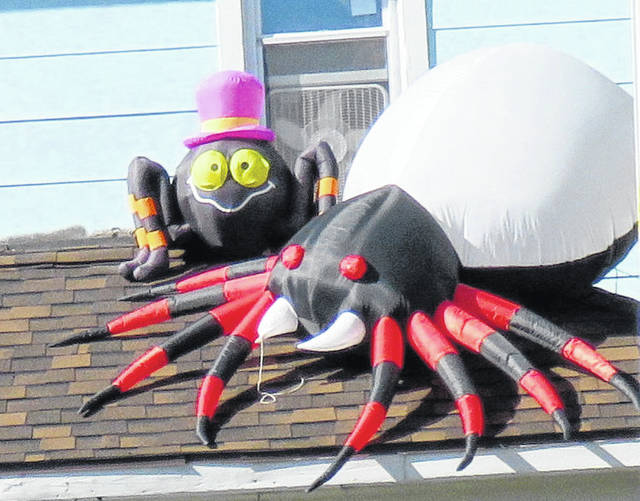

Hailing from Poland, my wife Gosia has chirped with delight all October as we gawked at elaborate Halloween displays in Darke County.
Even our helpful Ohio Gas & Electric repairman showed up with a skeleton sitting in his passenger seat after our pilot light winked out.
“They don’t do things like that in Warsaw,” she said.
Gosia grew up in Poland in Communist times during the 1960s. The priests in her church discouraged devil masks as satanic.
Not until 2017 did costumed children started appearing at the door of her family’s flat. “Cukierek albo psikus,” they cried, giving the Polish phrase for trick or treat.
Gosia was unprepared but nonetheless dug out some candy that she had hidden from her mother, a diabetic.
My wife and I share a love of scary stories.
We both were Scouts.
We each loved being frightened to death as our Scout leaders told ghost tales around flickering, roaring campfires.
Our last vacation to Maryland before the pandemic hit, we spent an afternoon visiting the tiny Baltimore house of Edgar Allan Poe, creator of terrifying tales. As a boy my reading of “The Tell-Tale Heart” made me hide later under the bed-covers.
In this column I plan to tell a true horror story I’ve written for my upcoming book “Hazing in American Culture.”
The story started out innocently enough in a remote county in Utica, Kansas.
Utica was created to serve the needs of sodbusters homesteading in “Bloody Kansas” in the 1870s.
A school superintendent at Utica High School named W. H. Sallee decided he’d make the annual initiation of freshmen memorable but supposedly safe.
The year was 1957. School boards everywhere had not yet banned “Dazed and Confused” hazing.
Mr. Sallee permitted the seniors to create a haunted house to scare the new kids.
They chose an abandoned farmhouse. They decorated the rooms with spiders, goblins and leering pumpkins.
Then Mr. Sallee and his seniors rigged a rope to the ceiling in one of the rooms. They made the scene look like an execution.
Mr. Sallee slathered his face with fake blood.
Seniors brought small groups of wide-eyed freshmen into the unlit room.
A senior flicked on a searchlight. Mr. Sallee “hung” with the rope draped across his body. He moaned like the Kansas west wind.
The youngsters screamed and bolted.
Finally, senior class sponsor Betty Stevens was ready to call it a night. She and the students thought they’d take a souvenir photo.
Now it was the colleague and seniors who screamed.
Not even Edgar Allan Poe’s morbid imagination could have conjured what they discovered.
The house was now haunted — for real.
A prop that Mr. Sallee had put under his feet for balance had slipped. He dangled in the pitch-dark chamber.
Rope burns covered his neck.
An autopsy called the cause of death “accidental strangulation.”
Law enforcement investigated the mystery of the superintendent’s demise.
“We don’t know for sure what happened,” county undersheriff Jack Gantz said to a reporter. “We believe he fell and struck his neck on the rope.”
Ever after, Utica continued to lose population, particularly that of young persons. The 2018 population fell to 144.
Utica High School graduates marched off to study at Fort Hays State University and rarely returned.
The houses that remained were well kept. Old timers met for coffee every day at the breakfast hangout, a cafe. Services continued at the First Christian Church and United Methodist Church.
But after high school classes dwindled to just a few enrolled students, authorities shut it down and offered the school building for sale.
Then in 2008, Utica City found itself again in the national spotlight. Once again, reporters told a shocking story.
A former Utica student named Pam had left town for Ness City to live in the yellow-and-white trailer of a boyfriend named Kory.
Unknown to anyone but him and her, Pam suffered from a phobia.
Her story might have shocked even Dr. Oliver Sacks, author of “The Man Who Mistook His Wife for a Hat.”
Pam refused to leave the trailer. Then she refused to leave the trailer’s bathroom.
She ate in the bathroom. She kept clothing in the bathroom. She did what everyone else does in a bathroom.
Unbelievably, Kory went along with this delusional existence. Instead of getting help, he left her a stack of meals for the day and worked at an antique store.
When Pam’s relatives from Utica came to see her, she screamed through the bathroom door that she never wanted to see them again.
Predictably, things grew worse.
For months, she stayed on the throne. Her buttocks developed gaping open sores. Fluids from the infection dried and glued her bottom to the toilet seat. Predictably, her leg muscles atrophied.
At long last, Kory called authorities.
Law enforcement officers gasped from the stench they encountered upon entering the trailer.
They had to pry off the toilet seat with her bottom still attached to it. Otherwise, they feared removing slabs of flesh.
Fortunately, medical intervention, surgery, antibiotics, and mental counseling saved Pam’s life.
Kory was charged with neglect and pleaded guilty. Pam asked the court for leniency. He served no jail time.
However, Kory apparently had a bad habit of his own. Police charged him with being a “Peeping Tom” upon the repeated complaints of neighbors.
This time the court sentenced him to six months in jail.
Kory and Pam are still together according to their social media accounts.
In Facebook photos, she’s wheelchair bound but the two of them broadly smile at the picture takers.
The man who kept his wife in the bathroom has a pandemic greeting on the Facebook page’s profile photo.
It reads, “Stay at home.”
Oh, yes. Kory made the news one time more.
He won the Kansas lottery twice in one year.
Now that’s scary. “Cukierek albo psikus.”






